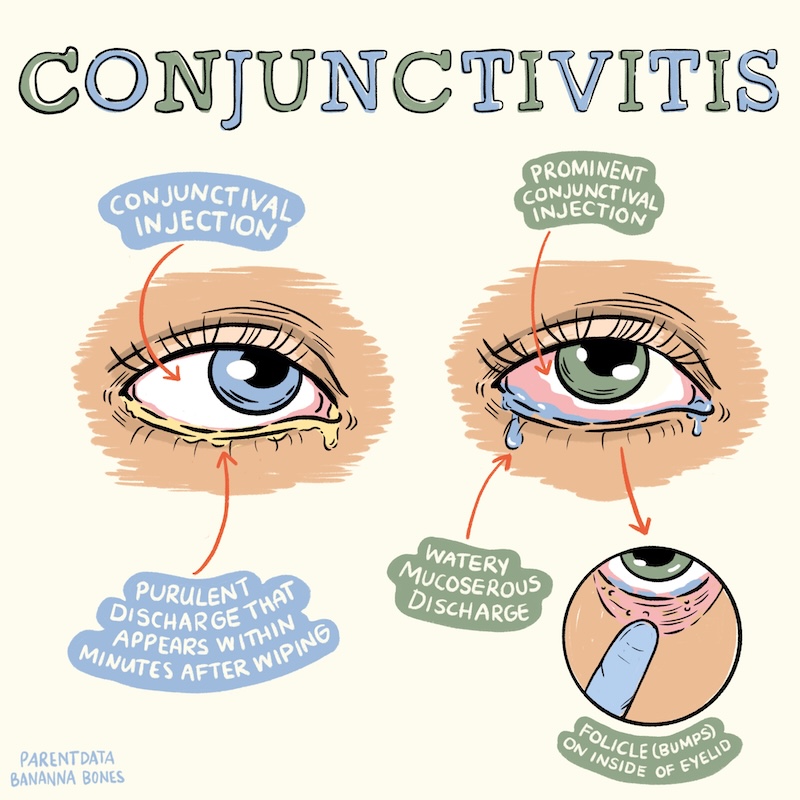“Pink eye” is not a technical term. In fact, today’s topic is conjunctivitis, which translates to “inflammation of the conjunctiva.” The conjunctiva is the membrane under your eyelid and that covers the eye surface. Normally it’s see-through, leading to the whites of your eyes being white. When this membrane is inflamed, it appears pink or red.
Red eyes have a variety of causes, not all of which are conjunctivitis. However, for kids, it is by far the most common reason they would have a red- or pink-appearing eye.
Conjunctivitis is not a disease itself; it’s a description of a symptom, and it can have many causes. Which one it is will determine treatment, as well as whether they are contagious. I’ll talk through the possible causes below and then whether you can distinguish them (it’s hard).
What are the causes?
Broadly, there are three causes of inflammation that may play a role here: bacteria, a virus, or some external issue.
Bacterial infection
Bacterial conjunctivitis is caused by a bacterial infection. In kids, the most common causes are Streptococcus pneumoniae, Haemophilus influenzae, and Moraxella catarrhalis. Honestly, it really doesn’t matter which of these it is, and you’ll probably never know. Some bacterial STDs (chlamydia, gonorrhea) can also cause conjunctivitis, but this wouldn’t be common in children.
Bacterial conjunctivitis is usually in one eye, and the discharge from the eye is typically a thick pus, in yellow, white, or green color.
This condition is highly contagious and spreads through contact with people or objects. You wipe your child’s eyes and then touch your eye — you’re done. If you share a towel, also done. Careful hand-washing is your friend, but contagion is hard to avoid.
This condition can be treated with antibiotics, typically ointment or drops (ointment is usually easier for children). Notably, the condition will generally get better even without antibiotic treatment, but the treatment can make it resolve faster.
Viral infection
The most common viral cause of conjunctivitis is one of a variety of adenoviruses. There are many types, so you can get this many times. Sometimes kids have other cold or fever symptoms alongside, sometimes it’s just the eyes.
Generally, viral conjunctivitis is in both eyes. This is not because it spreads between eyes but because the underlying viral illness is a common cause for both eyes. The discharge is watery — less pus-like than with a bacterial cause.
This type of conjunctivitis is also very contagious and spreads between people through touching or shared products.
Very important (more on this below): Viral conjunctivitis cannot be treated with antibiotics. They will not work, because they do not kill viruses. Treatment is supportive — warm and cold compresses, sometimes a topical antihistamine. That’s it. You just have to … wait until it gets better.
External causes
There are reasons for eye inflammation that are external. This includes allergies, chemicals that get into the eye, and dirt or other irritation. In many cases, it may be obvious that this is what is going on — if there was a chemical exposure, or a big piece of dirt in the eye. Allergies tend to present with other symptoms.
How do you know what type it is?
The most important distinction is between bacterial conjunctivitis and something else, either viral or allergic. If the cause is bacterial, topical antibiotics can help resolve it faster. If not, then they will not help, and there is no point in using them. Given the desire to be cautious about overuse of antibiotics, we really want to limit their use to cases in which there is a bacterial infection.
There are two helpful distinguishing features of bacterial conjunctivitis relative to other types:
- Thick pus versus watery discharge. Bacterial conjunctivitis produces more pus; both viral and allergic conjunctivitis produce a more watery discharge. An important note is that in all cases, the discharge may seem thicker early in the morning because it dries overnight (often resulting in eyes stuck closed in the morning). Once you’ve wiped this off, you can then start to see better whether the ongoing discharge is thick and pus-like or more watery.
- One eye versus two. Bacterial conjunctivitis is more likely to be only in one eye. It is certainly possible for it to be in two, since the infection can be spread between the eyes. But it typically presents as a single eye infection, whereas both viral and allergic conjunctivitis usually affect both eyes (not because of spread between eyes but because of a common underlying cause).

Having said this, the diagnosis here is not necessarily obvious (not even to doctors sometimes), so this is a case in which an in-person or video visit may be a good idea.
A note: A common issue for doctors with pink eye is that patients request antibiotics, often without even being seen. This is sometimes due to a misunderstanding of the causes, and probably more often due to child care settings in which return to care is predicated on treatment. This is problematic because antibiotic treatment, as noted, is not effective for viral conjunctivitis. It is important for a doctor to get a look at the eye before diagnosis, and for us as patients it’s important to understand that there are some situations in which there is no reason to prescribe anything other than waiting it out.
When can your child return to school?
This is a tough one. Conjunctivitis is extremely contagious. Many child care centers and schools have a 24-hours-after-treatment rule: you can return after 24 hours of treatment.
If the conjunctivitis is bacterial, then contagion is greatly lessened after 24 hours of antibiotic treatment. In this case, that’s a reasonable approach to return to school.
If the cause is viral, this rule makes no sense. Treatment with antibiotics will not work, so it is both a waste medically and false reassurance. Ideally, we’d treat this like a cold and wait until the symptoms largely go away, but that can be an infeasibly long time. A general approach similar to how colds are treated — improving symptoms, no fever — is probably realistic for most settings.
If the conjunctivitis is caused by allergies or some kind of chemical, there is no risk of contagion, so school attendance should not be affected.
The bottom line
- “Pink eye” is a symptom, not a cause, and there are three common causes: bacterial infection, viral infection, or an external reason.
- If the cause is bacterial, topical antibiotics can help resolve it faster. If not, then they will not help, and there is no point in using them.
- Rules requiring 24 hours of treatment before a return to school may not be well thought out given the common viral cause.





















Log in